Alibre Design 9.1-Opening Up 3D Design
Alibre Design provides 80% of the functionality of the establishedmid-range MCAD applications at about 20% of the cost. The results are highly satisfying.
Latest News
December 1, 2006
By Mark Clarkson
Way back at the end of the last century, when Solid Edge and SolidWorks were still relatively new, I remember talking with representatives of both companies about those products and what they did and didn’t do. The philosophy was that while they didn’t do everything the “big” MCAD products (such as CATIA) did, they did the 80% that most engineers did most of the time, and they did it for a lot less money.
Now, fast-forward to today and both Solid Edge and SolidWorks have become long-established and extremely powerful CAD/CAM programs. And now along comes Alibre promising 80% of their functionality for a lot less money. “The circle of liiiiiife….”
Building Parts
Alibre Design 9.1 is a 3D solid parametric modeler, built around the ACIS kernel. If you’re familiar with solid parametric modeling, you’ll feel right at home with Alibre from the get-go. Even if you’re not, Alibre starts you off with some good basic tutorials (both written and video) on sketching, part modeling, and assemblies. Anyone with a modicum of MCAD experience should be up and producing in a day or two.
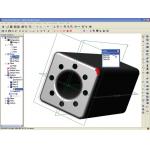 |
| Alibre Design 9.1 |
Figure 1: Alibre uses interactive, context-sensitive prompts on the bottom left-hand side of status bar to aid you as you progress through a design.
To build a part, you generally start with a 2D sketch, define and constrain your dimensions, then pop things into the third dimension via standard tools (extrude, sweep, revolve, etc.). A status bar at the bottom of the screen provides interactive prompting as you go: “Select the axis of symmetry,” “pick center point for the circle,” and so forth (see Figure 1, above).
I do have a tiny quibble with the interface. Even at 1024 x 768 on a 22-inch monitor, the difference between, say, the Fillet and Chamfer buttons is well nigh invisible, at least to my old eyes. I don’t want bigger buttons, but perhaps a reworking of some of the universally understood icons is in order. (Tooltips do indeed pop up to disambiguate things.)
I won’t attempt to enumerate them, but Alibre Design provides all the basic tools for 2D and 3D sketching as well as for creating solids and adding features to them.
Alibre places a conventional history tree—called the Design Explorer—to one side of the part space, showing every sketch, feature, and surface, as well as the axes and design planes for easy selection (see Figure 2, below). You can select, edit, and re-order everything from here.
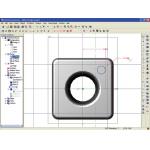 |
| Alibre Design 9.1 |
Figure 2: From its Design Explorer, visible on the left, Alibre provides access to each aspect of your design.
Each major task—creating or editing a part, a sheet metal part, an assembly, a drawing, or a bill of materials—takes place in its own customizable workspace. Design Explorer is available in all Alibre’s workspaces. In Assembly, for example, the Design Explorer shows all your parts, constraints, relationships, and views.
Building Assemblies
Alibre’s assembly module is surprisingly robust. It took me a while to get comfortable with setting constraints and mating parts in an order that kept all my surfaces where I could get at them but, in the end, you can put together some pretty complex assemblies (see Figure 3, below). Alibre does interference checking and, with Alibre Motion, lets you move assemblies in real time and create animations easily. You can rotate the crankshaft on an engine, for example, and watch the pistons travel up and down within the cylinders.
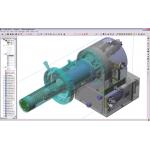 |
| Alibre Design 9.1 |
Figure 3: This Alibre assembly design depicts an Instrument that produces an atomic beam of evaporated material using a vacuum plasma discharge. Created by Stephen Davies.
You can explode your assemblies, either automatically or manually, to create exploded views, although in my experience the automatic explosions require a bit of manual tweaking. You can generate parametric drawings and associative bills of materials from your assemblies.
Collaboration
Alibre Design feels a bit like a light version of familiar mid-range CAD programs like Solid Edge and Pro/Engineer. It does just what you expect it to do, just the way you expect it to do it. It would be a solid but unexciting “me too” product if it were not for two things: its price and its collaboration capabilities.
Alibre is built around collaboration; collaboration is at its core. You start every session in Alibre Design at a sort of “home page.” Here you can initiate a new design, access part libraries and tutorials, and perform a host of other high-level tasks.
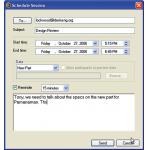 |
| Alibre Design 9.1 |
Figure 4: Collaboration is key to Alibre Design.
But here you can also manage contacts and teams, schedule and conduct online sessions, manage repositories of parts and assemblies for collaborative work, and access the Alibre Design online community. You can send instant messages, conduct design meetings, and interactively mark up drawings, parts, and assemblies, over the Internet, intranet, or LAN (see Figure 4, above).
All collaboration is via peer-to-peer; you need never leave the security of your firewall.
Free Free Free!
What about price? Well, the Xpress version of Alibre Design is completely free. Alibre Design Xpress is a feature-limited version of Alibre Design—there is no 3D sketching, for example, and assembly size is limited. Alibre’s collaboration features are disabled, as well. But Xpress is still a fully functioning 3D solid parametric modeler, more than adequate in and of itself for many small shops. Download it at Alibre’s home page, where you can also register for a free 30-day trial of Alibre Design.
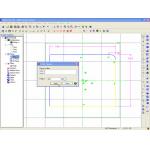 |
| Alibre Design 9.1 |
Figure 5: An example of using the Alibre Design 9.1 fillet operation.
Alibre Design starts at $995, though I’ve seen it for less. The Pro and Expert versions go for $1495 and $1995, respectively. They add considerable functionality to the basic package, including 3D PDF publishing, photorealistic rendering, 3D motion analysis and animation, SprutCAM and ALGOR DesignCheck.
Alibre charges an annual maintenance fee of $295 to keep collaboration active and everything up to date.
The Verdict
For some reason, I had a hard time getting the hang of rotating parts and assemblies, and I never ceased to pine for a Spaceball or Astroid. But, all in all, Alibre Design is a great piece of software. I don’t think it will pull many users away from their old standby fuller-featured packages, but Alibre Design will and does go a long way toward opening up modern 3D CAD for a whole new tier of users.
Highly recommended.
Mark Clarkson has been writing about all manner of computer stuff for years. An expert in computer animation and graphics, his newest book is Photoshop Elements by Example. Visit him on the Web at markclarkson.com or send your comments about this article through e-mail by clicking here. Please reference “Alibre 9.1 Review, December 2006” in your message.
Companies Mentioned
Alibre Design Xpress, Alibre Design Professional, Alibre Design Expert
Alibre, Inc.
Richardson, TX
Astroid
Spatial Freedom, Inc.
Needham Heights, MA
DesignCheck
ALGOR, Inc.
Pittsburgh, PA
Spaceball
3Dconnexion
San Jose, CA
SprutCAM
Tokay Tech, Inc.
Naberezhnye Chelny, Russia
Image Gallery
Here are some additional Alibre Desing 9.1 images demonstrating the type of designs it can handle.—DE Editors.
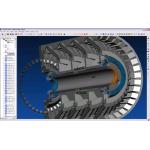 |
| Alibre Design 9.1 |
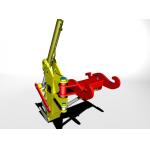 |
| Created by Marco Hobelman of Hobelman-Halle. |
On the left, an expanding Mandrel used to cut sleeves of material of different diameters on the same machine. A swing stick end of an excavator with rotating head.
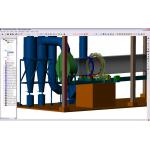 |
| Created by Nestor Rueda Vallejo of Indisa S.A. |
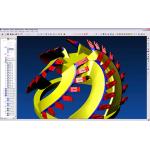 |
| Courtesy of Brett Long. |
On the left, a rotary dryer created for use in the mining and cement industry. On the right, a cutterhead for a cutter suction dredge. This model features replaceable teeth and is used for cutting rock on the bottom of waterways.
Subscribe to our FREE magazine, FREE email newsletters or both!
Latest News
About the Author
Mark ClarksonContributing Editor Mark Clarkson is Digital Engineering’s expert in visualization, computer animation, and graphics. His newest book is Photoshop Elements by Example. Visit him on the web at MarkClarkson.com or send e-mail about this article to [email protected].
Follow DE





